Ijraset Journal For Research in Applied Science and Engineering Technology
- Home / Ijraset
- On This Page
- Abstract
- Introduction
- Conclusion
- References
- Copyright
A Study on Work-Life Balance of Employees in the Digital Age
Authors: Prathiba N, Dr. Neena P C
DOI Link: https://doi.org/10.22214/ijraset.2024.61252
Certificate: View Certificate
Abstract
In the digital age, when cutting-edge technologies have completely changed the nature of employment, this study investigates the complex dynamics of work-life balance. The study investigates how employees\' capacity to strike a balance between their personal and work obligations is affected by technological breakthroughs. Key elements such as flexible hours, technology for communication, working from home, and employee well-being are examined in this study using a mix of surveys, interviews, and data analysis. The study highlights the value of company policies, boundary-setting, and communications in reducing possible risks to workers\' well-being. Examined include long-term effects on professional development, job satisfaction, and retention. In the end, the research offers complete policy suggestions for companies and greater harmony between work and life in the digital age, taking into account the changing needs.
Introduction
I. INTRODUCTION AND REVIEW OF LITERATURE
A. Introduction
The degree to which a person focuses on both their professional and private lives, as well as the extent to which work-related tasks are conducted at home, is referred to as work-life balance. These days, WLB (work-life balance) is the primary concern because of the proliferation of technology, which negates the significance of physical location in determining WLB. It is imperative that people comprehend the significance of WLB in the digital era. It assists the company in formulating regulations, keeping lines of communication open with the employees, developing employee happiness and growth within the workplace, defining limits, placing a high value on self-care, and establishing a healthy division between work and private life. It is a never-ending and constant journey. Planning and making strategies is made easier by human resource management. The digitalisation gives more freedom to shape our work-life and it is more flexible to work when, where, and how we want to.
Working remotely and at any time is now available because of developments in handheld devices, cloud-based software, and the internet. Technology has changed how we operate in the digital age. The boundary between personal and professional activities might become more blurry as a result of technological improvements, making it more difficult to maintain a healthy work-life balance. A disturbed equilibrium between both professional and private life can result in stress, burnout, and a decline in productivity. Due to differing employee perceptions, gender discrepancies may result in an unbalanced work-life schedule. Employee inequity has an impact on behaviors and attitudes, low motivation, low productivity, disinterest in the work or task, and a reduction in overall performance. This study supports changes in policies and practices by highlighting issues with workers' capacity to strike a work-life balance.
Work-life balance is increasingly an issue for any country. For any country, the two biggest work-life balance problems are:
- People with not enough work or income.
- People who have too much work with low paid income who work for long hours.
WLB enhances productivity, aids in maintaining attention, reduces stress at work for workers, and facilitates their lives in several other ways. Work-life balance benefits include attracting new hires, assisting with staff retention, enhancing the mental and emotional well-being of employees, improving working relationships among coworkers, motivating employees to demonstrate greater interest and teamwork, and raising production and satisfaction levels.
A good work-life balance is profitable for both employees and employers. Work-family conflicts occur when demands of work life creates problems in fulfilling the demands of family life. The use of digital technologies improves coordination and knowledge sharing between individuals, leading to better work-life balance and improved job output. The work-life balance of employees involves reducing work-related stress, and establishing a positive stable environment while maintaining the health and well-being of employees in the company.Processes are accelerated in workplaces thanks to technology. The ways that digital innovation improves human life include time savings, more communication options, improved network connectivity, artificial intelligence, and big data technology.
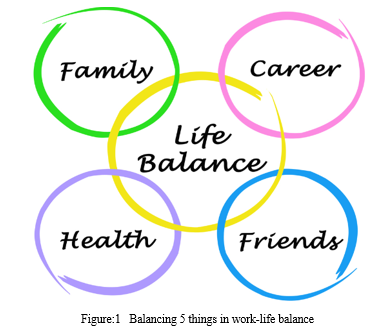
B. The Rationale For The Study
The purpose of this study is to determine how successfully workers manage their personal and professional life. Achievement depends on striking this balance, which is impacted by a variety of factors including social life, emotions, the sort of employment, the workplace, and family history. Those who can strike a balance between these factors typically do better at work.
The digital age we live in nowadays is altering the way we operate. It's more flexible and connected, but it also makes it more difficult to distinguish between business and personal life. Employers who make intelligent use of technology can draw in and retain talented staff. Support from businesses in striking a balance between work and personal life increases employees' enthusiasm and dedication to their careers.
My research on the subject of work-life balance for employees in the digital era will enable me to gain a thorough understanding of the modern workplace and the latest innovations employed there. It is going to help me as a student of HR in terms of my future career development. It therefore becomes imperative that I conduct this research on this specific topic.
C. Challenges Of Wlb Of Employees In The Digital Age
Juggling both your professional and private life can be difficult when you're always connected. It's difficult for us to differentiate between jobs and time for ourselves when we're always checking our messages or talking about business-related topics regardless of work. Working from anywhere at any time is made more difficult by the availability of digital tools, online chat rooms, and smartphones.
Achieving a healthy work-life balance has become more difficult than ever in the digital age, where connectivity is constant and work has no bounds. The boundaries between one's professional and private lives are frequently eroded by the usage of technology. Employees' work-life balance has been impacted by the COVID-19 pandemic since more and more people are working from home. Rapid access makes people unmotivated, and they spend their time on the internet, Netflix, and online games.
Working from home can cause us to lose our balance and find it difficult to concentrate. It's simpler to become sidetracked and lose interest in our work when we're not at the workplace. Being surrounded by superiors and fellow employees at work encourages us to stay focused and complete tasks on schedule. However, we could feel a little disengaged and less inspired to continue being productive at home.
One of the main obstacles to work-life balance people confront is stress. Excessive stress can cause fresh concerns such as a poor work-life balance, and it can be challenging to address these issues if it is not addressed or acknowledged right away.
???????D. Review of Literature
Wright and McMahan (2011) discovered that HR managers have adopted a range of practices in today's dynamic workplace with the goal of boosting staff productivity for success at all levels of the company, whether it be individual, group, or corporate. Administrative competitiveness permeates the workplace as everyone strives to hire and retain the best candidates available. Therefore, in order to obtain a competitive advantage, businesses need to consider their satisfaction(Boxall, Ang, and Bartram, 2011).
According to Barrera (2007), The idea is defined as employers collaborating positively with employees to create plans that balance the needs of the company with the personal lives of their staff members. This idea makes it very evident that both the employer and the employee bear responsibility for striking a balance.
Greenhaus, Collins, and Shaw (2003) define it as "the extent to which a person participates in and finds equal fulfillment in both their professional and personal responsibilities." Recently, work-life balance has become a significant issue for workers' wellbeing. From this angle, an organization's principal resource that needs to be addressed is its human capital. Happiness and well-being among employees are the other essential elements that are necessary for a company to develop. Work-life balance is a concept that has grown in popularity recently. This may be connected to the growing complexity of work, the need for concentration, the need for higher productivity and efficiency, the entry of women into the service sector, and an increase in rivalry in the economy.
Haar, Russo, Sune, and Ollier-Malaterre (2014), It is a person's assessment of how well they manage multiple responsibilities in life. All of these definitions demonstrate that work-life balance is a blend of family and job. Multiple researchers have also shown that work includes assigning official duties to employees in order to achieve goals, and life consists of a variety of tasks that are not typically associated with work, like taking care of the home and children. In this scenario, work-life balance is achieved when work and life operate in balance with each other.
Au and Ahmed, (2014) One area of particular importance for businesses to focus on when trying to identify ways to save human resources is employee work-life balance management. Enhancing workplace well-being requires addressing people's access, which is crucial for the operation of the company. Due to the expanding rivalry of business settings, managing human resources is now important to today's companies.
Westman and Wurtz (2016) It is crucial to emphasize that work-life balance can have positive effects on employee quality and business performance. Because of this, it's also crucial to remember that, despite the seemingly endless list of reasons for work-life balance, everyone seems to agree that, on the one hand, work is defined as a set of formal tasks done by an individual or group while holding a specific job position, and, on the other hand, life is defined as a set of non-work-related activities like housework, taking care of the elderly, and raising children (Anwar, Hansu, and Janjua, 2013).
Lee and Bruvold (2003), A causal sequence of events that stimulates employee performance from ideal human resource practices to actual practice is generated by the perceived value and care associated with workers. Since employee performance plays an integral part in achieving organizational goals and objectives, it is vital to the company.
Purcell et al. (2009) demonstrated that work-life balance (WLB) has played an important part in creating a high-performing culture that contributes to quality and ultimately increases shareholder value through productivity, customer service, and growth.
Darko- Asumadu (2018), According to this study, older employees are more dedicated and achieve in creating a work-life balance greater than younger employees. This study suggests older employees may be less able to deal with workplace pressure as their working lives close to a close, that may cause a decline in workload and, in turn, a reduction in work-family conflict (Osei-Tutu, 2018). It can be done to examine work-life balance ideas by the use of demographic variables such as age, gender, marital status, and parental status.
Darko-Asumadu, Osei-Tutu Sika-Bright, (2018) stated that employees' ability to balance work and non-work activities, along with being satisfied with their position and working conditions, are the main factors impacting the relationship between work-life balance and commitment to work. When employees are offered the flexible rules and show a positive attitude in their job commitment, businesses could do well in global markets for great values.
Safaria et al. (2011), reported that decreased employee productivity is one of the negative consequences of role conflict-induced occupational stress. They could have a problem with absence in their company; if this occurs often, they might be dismissed and intend to leave; interpersonal interactions will play a role in turnover. From my vantage point, relationships at work are the ongoing interactions between employees, management, and coworkers. These connections are a normal part of the job and usually lead to benefits for the employees since they help each other out when things grow difficult.
Garg (2016), has an excellent effect on employee retention. The outcomes of Garg's study indicate that in order to give workers the belief that their employer supports their integration of personal and professional lives, companies should increase their use of work-life balance options including flexible scheduling, delegating tasks, and taking breaks.
II. RESEARCH METHODOLOGY
???????A. Scope Of The Study
Finding an equilibrium between your professional and private lives is the aim of work-life balance. This study investigates the pros and cons of work-life balance, the factors that impact it, the influence it has on people, and methods to promote it.
The way we operate has always been transformed by digital. We have greater flexibility to design our work-life balance, but it also creates boundaries between our personal and professional lives.
This research addresses the conflicting demands of work and family, examines various work-life balance strategies, and outlines what employees may do to put them into effect.
The goal of this is to identify the variables influencing workers' work-life balance. It shows how well workers are able to manage their personal, social, and organizational responsibilities. This research determined the different steps that the company should take to enhance workers' quality of life at work and create an atmosphere that inspires motivation and satisfaction. Enhancing people's quality of life while increasing chances for professional advancement and paid work are the goals of work-life balance.
???????B. Research Objectives
This study aims to investigate the relationships between work-life balance and several factors, including gender, marital status, age, religion, family structure, education level, length of employment, financial status, and the presence of childcare or eldercare duties.
- To investigate the connections between factors associated with the job, such as demands, autonomy, involvement, time spent on the job, stress, and security.
- Understanding how employees' personal and professional lives are impacted by stress is made easier with the aid of work-life balance.
- The goal of this study is to obtain a comprehensive understanding of employees' work-life balance.
- To know what is meant by work-life balance as it relates to employment relations.
- Determines the elements influencing the work-life balance of the staff.
- To recognise the connection between a worker's personal life and their place of employment.
- To make suggestions on how to increase workers' happiness with their work-life balance.
- To understand how crucial work-life balance is for both businesses and workers.
- The study offers a survey on the general aspects of workers' work-life balance and aids in introducing new techniques and using alternatives as well as adjusting to various technological advancements.
- After analyzing, organizing, planning, and carrying out the plan, it provides a report that can be compared to the current report and examined at a later time for future reference.
The research aims to support the HR department's efforts to improve employee benefits, successfully strategize, cultivate a healthy work environment, inspire employees, and use contemporary technologies to ensure work-life balance.
???????C. Framing Of Research Hypothesis
A hypothesis for research is a prediction or anticipation that will be investigated through study. An assertion that can be validated or refuted is called a hypothesis. Work-life balance has a beneficial impact on digital workers' job performance.
A research hypothesis is a statement that suggests a connection between two or more variables, most of which are classified as independent or dependent variables. It is imperative that the investigation on the idea be restricted and specific.The hypothesis must also make sense in light of the research questions. Clarity on the study topic and aims is provided by the hypothesis.
The expected results or the research's outcome are described, explained, and predicted. It also guides the research study procedure and specifies the kind of research design. Data collection, processing, and interpretation are made easier by additional hypotheses.

???????E. Methods For Data Collection And Variable Of Study
The process of collecting and evaluating data on topics of interest in an organized manner is known as data collection. This enables us to test our hypotheses, discover the results of our study, and find solutions to our research questions. After data collection, it's critical to correctly organize it. Many organizations gather information in order to make predictions regarding future events.
"Data" is the primary source used in the data collecting techniques. Two categories of data exist: main and secondary data. Primary data are those that are directly observed or gathered from first-hand experiences. answers obtained by means of surveys.Interviews and questionnaires are two examples. secondary data that was already gathered by another party. Surveys, observations, experiments, websites, publications, journals, etc. are a few examples.
Depending on the type of data, the data collection method is divided into two categories namely,
- Primary Data Collection Methods
Information gathered directly from first-hand sources through surveys, interviews, and observation is referred to as primary data, or raw data.
a. Questionnaires
Is a series of multiple-choice questions for surveys and statistical studies that may be printed or written. A questionnaire consists of a set of questions or items designed to elicit information from respondents on their beliefs, experiences, and views. Both quantitative and/or qualitative data can be gathered using questionnaires.
b. Interviews
A planned interaction in which one party asks questions and the other responds is called an interview. describes a one-on-one discussion between the interviewer and the subject of the interview. There are several kinds of interviews, including:
- Structured interviews
- Unstructured interviews
- Situational interviews
- Behavioral interviews
- Technical interviews
- One-to-one interviews
- Video or phone interviews
c. Observation:
The act of attentively observing or keeping an eye on something or someone is called observation. refers to the capacity to record observations of the environment and write a report. One method for gathering primary data and aiding in the creation of reports is observation.
2. Secondary Data Collection Methods
Information gathered by a party other than the user is referred to as secondary data. It's already collected data that has already undergone analysis. To put it another way, it's information that has been collected from original sources and is prepared for use by researchers in their own investigations. Because it enables researchers and analysts to build large, trustworthy datasets to address a variety of issues, secondary data is extremely helpful.
Among the secondary data are
- Company websites
- Journals
- Textbooks
- Magazines
D. Variables of Study
Age, gender, parental status, and work ability are the four elements that are taken into consideration while studying employees' work-life balance. variables include things like the amount of hours spent outside the house, the age of the children, the size of the family, the degree of control over one's work hours, and whether or not work hours are flexible.
III. DATA ANALYSIS AND INTERPRETATION
A. Data Analysis Process
a. Define why you need the Data Analysis: Finding out why and for what purpose data analysis is necessary is the first stage in the process. This stage aids in understanding the goal of the analysis and its need.
b. Begin Collecting Data from Sources: The next step after determining the goal of the data analysis is to start gathering data from all accessible sources, including primary and secondary sources. This action will serve as a foundation for a plan.
c. Clean Through Unnecessary Data: This is the part of the procedure that will take the most time for a data analyst. As the data is being cleaned, you will probably be:
- Eliminating big mistakes, copies, and outliners
- Eliminating unneeded data points
- Organizing the Information
- Closing significant data gaps
d. Begin Analyzing Data: Is the scientific use of logical and/or statistical tools to data to summarize, define, and assess it. The next stage is to start examining the data from the obtained data after removing any extraneous information from the data analysis procedure.
e. Interpret results and Apply Them: It is the goal of interpretation to comprehend the statistics that we have collected, examined, and shown. We fully describe the outcomes in this final stage. This stage enables us to interpret the results and use them wisely.
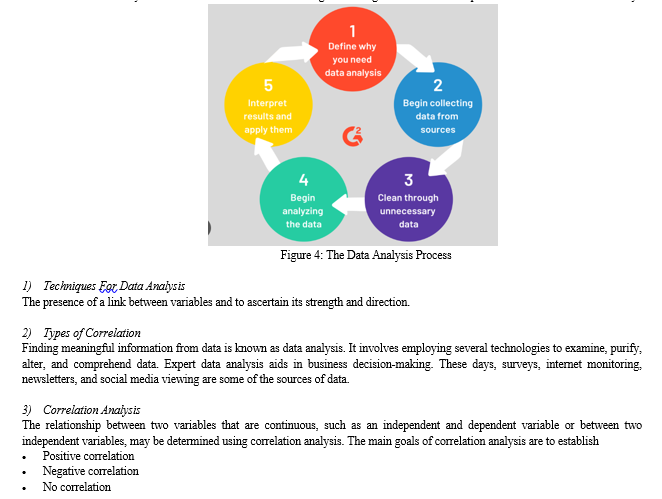
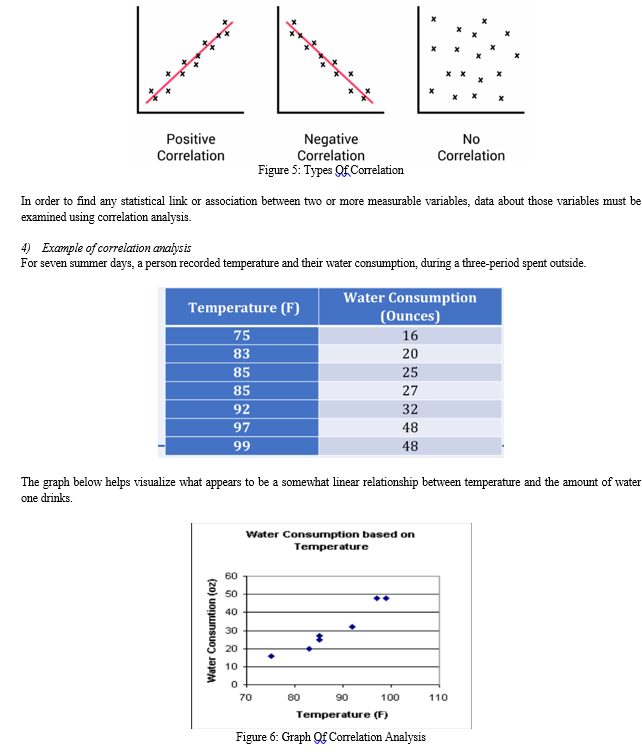

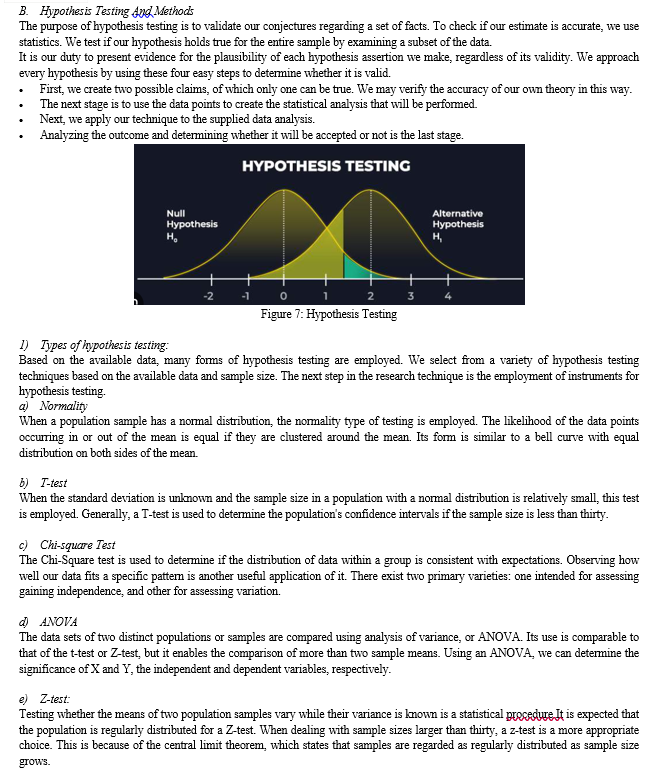
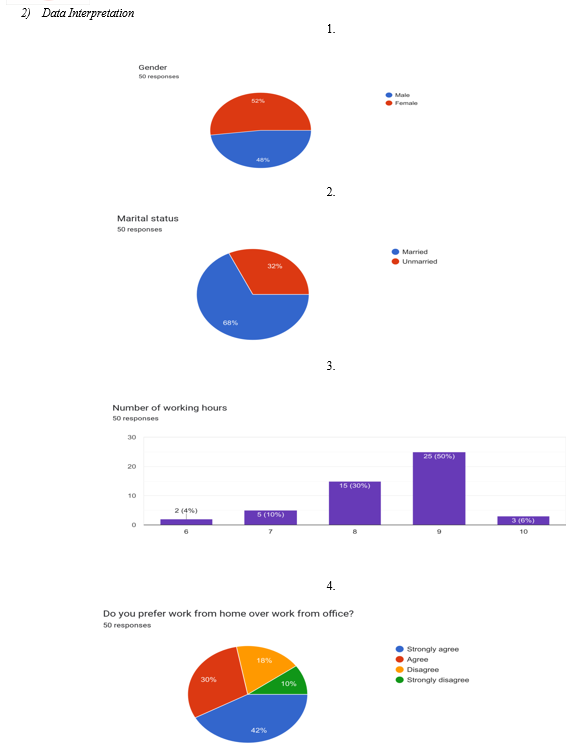
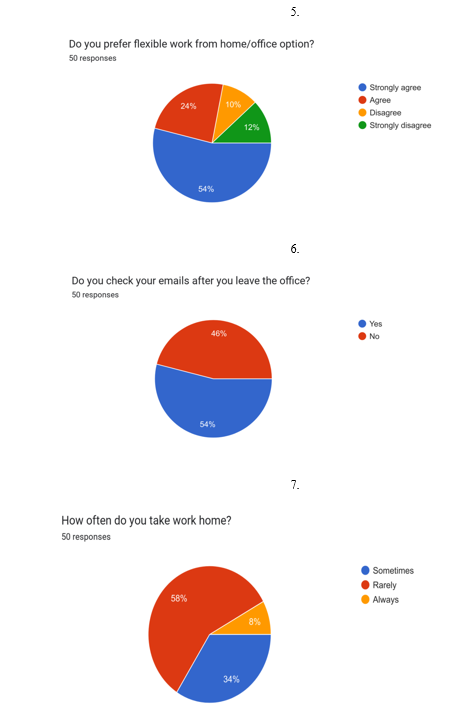
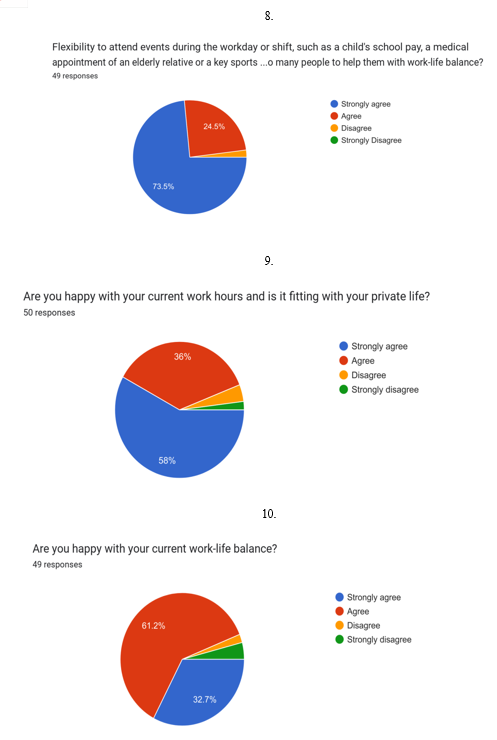

The previously mentioned research illustrates how workers balance their personal and professional lives, and an overall examination reveals how workers are adjusting to the digital world. A few workers said they would rather work from home than in an office. Work from home vs work in the office was preferred by 41.2% strongly agreed, 40% agreed, and 11.8% disagreed on average. Workers discovered that working remotely was more convenient than reporting to work every day. A small percentage of them chose to work three days from home and two days in the office, or vice versa. Following the introduction of the work-from-home option to stop the spread of illness among employees, employees' jobs were made easier. Over time, individuals gradually became accustomed to working from home.
IV. FINDINGS AND RECOMMENDATIONS
???????A. Research Outcome And Findings
The results of this study showed that workers' work-life balance positively impacted the culture of the company. The study's findings included higher output, improved time management, and a decline in staff absence and illness. Based on survey data, employees report feeling either extremely well balanced, moderately balanced, or balanced between their professional and personal lives. To put it briefly, workers are managing two separate lives.
Policies that support work-life balance benefit employees at work. In order to reconcile work and family, many employees desire a flexible schedule, which can increase productivity. Employees who successfully manage their personal and professional lives are less stressed and more productive. Studies reveal that persons who have a healthy work-life balance are better at managing their time and juggling their personal and professional lives. Thus, a positive company culture can enhance workers' work-life harmony.
This study also showed that a number of other organizational culture-related characteristics may have a big impact on workers, which may then have an effect on how well an organization performs. Due to its wide scope, this study may shed further light on the value that workers place on work-life balance inside the company. It also presents important perspectives on the topic and its overall effects on the company. It demonstrates how it affects overall organizational performance.
B. Recommendations
This research looked at how employees' work-life balance has changed in the digital era. The following adjustments and recommendations should be made in light of this study:
- Make it easy for workers to work remotely by providing them with flexible work schedules.
- Employees should promote effective time management to improve work-life balance.
- The workers require a holiday or a reprieve from their demanding jobs and from the stress in their personal and professional lives.
- Workers should talk to their bosses about any issues they are having at work, come up with solutions, and resolve the issues.
- Workers should set flexible schedules to enable them to harmoniously balance work and family obligations.
- Workers ought to leave their job at work and refrain from bringing it home, as this leads to conflict and miscommunication within the family.
Conclusion
Employees in every industry place a high value on their families and careers, and when these are not well balanced, tension and stress are generated. This study is significant because it attempts to understand how stress is caused by the intersection of job and family life. Nowadays, a lot of people and businesses are concerned with finding a balance between work and family. A life out of balance can be detrimental to a person\'s or a family\'s happiness and health. For this reason, an increasing number of businesses are considering implementing work-life rules. Organizations that respect each employee\'s right to a work-life balance and have a clear knowledge of their business case are more likely to have successful work-life balance policies.
References
[1] https://www.hrzone.com/hr-glossary/what-is-work-life-balance [2] https://www.linkedin.com/pulse/work-life-balance-digital-age-advise-your-career?utm_source=share&utm_medium=member_ios&utm_campaign [3] https://www.slideshare.net/khushbumalara/project-report-on-work-life-balance-of-employees [4] https://hospitalityinsights.ehl.edu/how-balancing-work-and-family-challenging [5] https://www.longdom.org/articles-pdfs/work-life-balance-a-literature-review.pdf [6] https://www.rsisinternational.org/journals/ijriss/Digital-Library/volume-6-issue-1/296-299.pdf [7] https://www.scribd.com/document/335503859/Objectives-and-Research-Methodology [8] https://images.app.goo.gl/QNKnAENsn6pudVsq5 balancing 5 things in work-life balance. [9] https://www.vedantu.com/maths/hypothesis-testing [10] https://images.app.goo.gl/9SkGX6NvAoXgW38w9 types of hypothesis. [11] https://images.app.goo.gl/oojtFPuUGtMWajzG9 the data analysis process. [12] https://images.app.goo.gl/oojtFPuUGtMWajzG9 the data analysis process. [13] https://images.app.goo.gl/VCnH3XRQ5NjkEuP97 hypothesis testing. [14] https://images.app.goo.gl/P7GEzGEnji9dgy2d7 types of correlation.
Copyright
Copyright © 2024 Prathiba N, Dr. Neena P C . This is an open access article distributed under the Creative Commons Attribution License, which permits unrestricted use, distribution, and reproduction in any medium, provided the original work is properly cited.

Download Paper
Paper Id : IJRASET61252
Publish Date : 2024-04-29
ISSN : 2321-9653
Publisher Name : IJRASET
DOI Link : Click Here
 Submit Paper Online
Submit Paper Online

